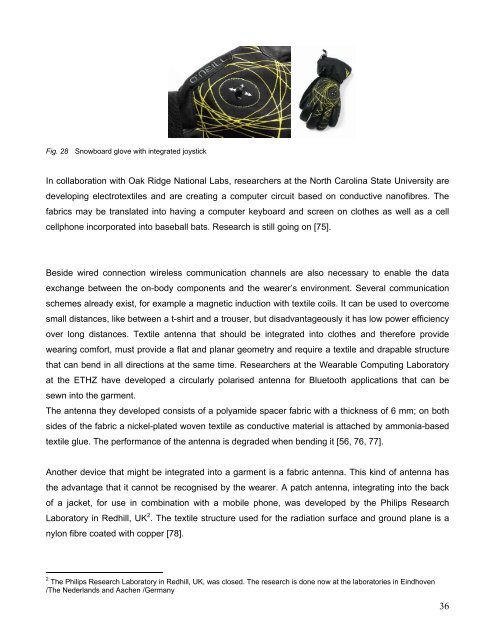Clevertex - Grado Zero Espace Srl
Clevertex - Grado Zero Espace Srl
Clevertex - Grado Zero Espace Srl
You also want an ePaper? Increase the reach of your titles
YUMPU automatically turns print PDFs into web optimized ePapers that Google loves.
Fig. 28 Snowboard glove with integrated joystick<br />
In collaboration with Oak Ridge National Labs, researchers at the North Carolina State University are<br />
developing electrotextiles and are creating a computer circuit based on conductive nanofibres. The<br />
fabrics may be translated into having a computer keyboard and screen on clothes as well as a cell<br />
cellphone incorporated into baseball bats. Research is still going on [75].<br />
Beside wired connection wireless communication channels are also necessary to enable the data<br />
exchange between the on-body components and the wearer’s environment. Several communication<br />
schemes already exist, for example a magnetic induction with textile coils. It can be used to overcome<br />
small distances, like between a t-shirt and a trouser, but disadvantageously it has low power efficiency<br />
over long distances. Textile antenna that should be integrated into clothes and therefore provide<br />
wearing comfort, must provide a flat and planar geometry and require a textile and drapable structure<br />
that can bend in all directions at the same time. Researchers at the Wearable Computing Laboratory<br />
at the ETHZ have developed a circularly polarised antenna for Bluetooth applications that can be<br />
sewn into the garment.<br />
The antenna they developed consists of a polyamide spacer fabric with a thickness of 6 mm; on both<br />
sides of the fabric a nickel-plated woven textile as conductive material is attached by ammonia-based<br />
textile glue. The performance of the antenna is degraded when bending it [56, 76, 77].<br />
Another device that might be integrated into a garment is a fabric antenna. This kind of antenna has<br />
the advantage that it cannot be recognised by the wearer. A patch antenna, integrating into the back<br />
of a jacket, for use in combination with a mobile phone, was developed by the Philips Research<br />
Laboratory in Redhill, UK 2 . The textile structure used for the radiation surface and ground plane is a<br />
nylon fibre coated with copper [78].<br />
2<br />
The Philips Research Laboratory in Redhill, UK, was closed. The research is done now at the laboratories in Eindhoven<br />
/The Nederlands and Aachen /Germany<br />
36

















